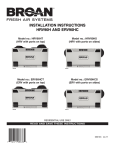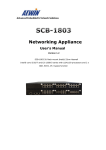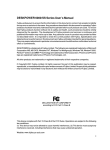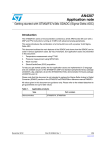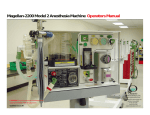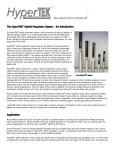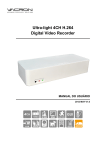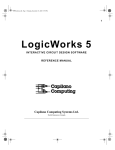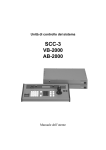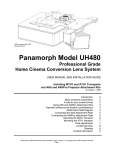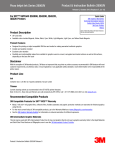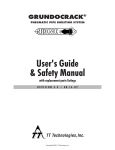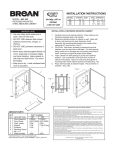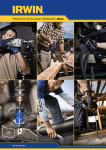Download Insert Project Number Here Project Template
Transcript
User’s Manual Edition 1/2007 OPTICHROM TM Model 11 Valve pro ces s p GAS CHROMATOGRAPHY Optichrom® Model 11 Valve For Stock Numbers 2000627-002 2000627-003 2000627-004 2000627-005 2000627-006 2000627-007 2000627-008 2000627-009 2000627-010 2000627-011 2000627-012 2000627-013 2000627-014 External Loop, Stainless Steel External Loop, Monel External Loop, Hastelloy Internal Loop (2 uL), Stainless Steel Internal Loop (2 uL), Monel Internal Loop (2 uL), Hastelloy Internal Loop (5 uL), Stainless Steel Internal Loop (5 uL), Monel Internal Loop (5 uL), Hastelloy Internal Loop, Stainless Steel, Flat Top Plungers External Loop, Monel, Flat Top Plungers External Loop, Hastelloy C, Flat Top Plungers Internal Loop (2 uL), Stainless Steel, Flat Top Plungers Revised Printing – January 2007 Repair Manual M06115 Copyright Notice © 1999-2007 by Siemens All rights reserved. This publication is for information only. The contents are subject to change without notice and should not be construed as a commitment, representation, warranty, or guarantee of any method, product, or device by Siemens. Reproduction or translation of any part of this publication beyond that permitted by Sections 107 and 109 of the 1976 United States Copyright Act without the written consent of the copyright owner is unlawful. Inquiries regarding this manual should be addressed to: Siemens Energy & Automation, Inc. 7101 Hollister Road Houston, TX 77040 U.S.A. Safety Practices and Precautions Safety First This product has been designed and tested in accordance with IEC Publication 1010-1, Safety Requirements for Electronic Measuring Apparatus, and has been supplied in a safe condition. This manual contains information and warnings which have to be followed by the user to ensure safe operation and to retain the product in a safe condition. Terms in This Manual WARNING statements identify conditions or practices that could result in personal injury or loss of life. CAUTION statements identify conditions or practices that could result in damage to the equipment or other property. Terms as Marked on Equipment DANGER indicates a personal injury hazard immediately accessible as one reads the markings. CAUTION indicates a personal injury hazard not immediately accessible as one reads the markings, or a hazard to property, including the equipment itself. Symbols in This Manual This system indicates where applicable cautionary or other information is to be found. Symbols Marked on Equipment DANGER - High voltage Protective ground (earth) terminal ATTENTION - Refer to Manual Safety Practices and Precautions, Continued Correct Operating Voltage Before switching on the power, check that the operating voltage listed on the equipment agrees with the available line voltage. Ensure that the power supply switch is to the correct input voltage. Danger Arising From Loss of Ground Any interruption of the grounding conductor inside or outside the equipment or loose connection of the grounding conductor can result in a dangerous unit. Intentional interruption of the grounding conductor is not permitted. Safe Equipment If it is determined that the equipment cannot be operated safely, it should be taken out of operation and secured against unintentional usage. Use the Proper Fuse To avoid fire hazard, use only a fuse of the correct type, voltage rating and current rating as specified in the parts list for your product. Use of repaired fuses or short circuiting of the fuse switch is not permitted. Safety Guidelines DO NOT open the equipment to perform any adjustment, measurements, maintenance, parts replacement or repairs until all power supplies have been disconnected. Only a properly trained technician should work on any equipment with power still applied. When opening covers or removing parts, exercise extreme care "live parts or connections can be exposed". Table of Contents Section 1 Section 2 Section 3 Section 4 Section 5 Introduction 1 Overview Capabilities and Applications Functional Description of the Model 11 Valve Filtering Purging Below the Seal Disc 1 1 2 2 2 Troubleshooting 5 Description Valve Leakage Plugged Valve Ruptured Sealing Disc Slow or Erratic Switching 5 5 6 6 6 Bench Test Procedures 7 Port-to-Port Leak Test 7 Repair 15 Description Cleaning of Flow Passages Disassembly and Inspection Cleaning Reassembly 15 15 16 16 18 Drawings and Parts List 21 i/ii Chapter 1 Introduction Overview The Model 11 Valve Maintenance Manual has preventative maintenance, repair and test information for trained plant personnel who are responsible for in-plant maintenance of the Model 11 Chromatograph Valve. In This Chapter This Chapter covers the following topics: Topic Capabilities and Applications Page Capabilities and Applications 1 Functional Description 2 Filtering 2 Purging Below the Seal Disc 2 The Model 11 valve can be applied in process chromatographs as a liquid or vapor sample valve, column switching valve, or a column backflush valve. It provides the uniform sample volume, high reliability (500,000 cycle life on clean gas), low internal volume, and high speed (switching time in milliseconds) required by process chromatography. Plus it provides the added benefits of minimum wear (critical parts move only thousandths of an inch for switching), dependable reproducibility and simplified construction for easy maintenance. See Table 1-1 for detailed specifications. The Model 11 valve body and cap are constructed so cleaning or replacement of sealing and cushion discs can be done without removing the valve from the chromatograph oven. Removal of three bolts allows access to the disc with no special tools required (see Chapter 4, Repair for detailed procedures). The specially constructed manifold eliminates leakage of air used for valve actuation. This feature is especially beneficial when bottled helium or nitrogen is used in place of instrument air. 1 Functional Description of the Model 11 Valve The Model 11 valve is a 6-port, two-position, air-actuated valve. The six ports are arranged in a circular configuration as show in Figure 1-1. Between each two ports is a plunger that opens or closes the passage between these two ports. A Teflon™ disc seals, prevents process fluids from contacting other components of the valve. This arrangement is shown in Figure 1-2. Six plungers operate in two sets of three. Each set of plungers is controlled by a spring-loaded, air-actuated piston so that one set closes three passages between ports as the other set opens three passages between ports. Passages between ports 1 and 6, ports 5 and 4, and ports 3 and 2 are normally closed. The other three passages between ports 1 and 2, ports 3 and 4, and ports 5 and 6 are normally open. The two operating positions of the valve are shown in Figures 12A and 1-2C. The two actuating pistons are spring loaded in a manner that assures that all six passages are momentarily closed during the switching operation (both energized and de-energized). This feature prevents unwanted mixing of streams during the switching cycle. The plungers and disc move only a few thousandths of an inch to permit flow through the passages. For external loop sample valve applications, ports 2 and 5 are connected externally by means of tubing as shown in Figure 1-1. The standard sample volume is 170 microliters. For internal loop sample valve applications, ports 2 and 5 are connected internally by means of a machined passage in the valve cap as shown in Figure 1-3. The standard sample volumes are: 2 and 5 microliters. Filtering The Model 11 valve must be protected against dirt, filings, column packing material, or anything else that might affect the Teflon-to-metal seal. Filter elements should be 5 micrometer or finer. Purging Below the Seal Disc Purging below the seal disc area may be necessary in a trap valve, when permeation through the seal disc causes air peaks or in a sample valve, when corrosive gases attack the seal disc cushion and/or other valve parts. (In the latter case the expected mean time between failure can be increased significantly.) Purging is normally accomplished with the carrier gas. 1/16 tube fittings are provided as inlet and outlet connections for the purge gas. Typically a tee can be placed in the carrier inlet line and a needle valve can be used to regulate the flow at 5 cc/min. 2 EXTERNAL SAMPLE LOOP Figure 1-1 SECTIONAL VIEW Figure 1-2 INTERNAL SAMPLE LOOP Figure 1-3 3 Table 1-1: Model 11 Valve Specifications 4 Internal loop sample size: 2 and 5 microliters standard. Other sizes on special request. External loop sample size: 15 microliters and larger. 170 microliters is standard. Sample filter: 5 micrometer recommended (not furnished with valve). Cap screw (33) Torque Setting: 35±1 inch pounds Base Screw (12) Torque Setting: 6.5±1 inch pounds Maximum operating temperature: 250°F (122°C) standard 15°F (66°C) 2000627-014 Maximum sample pressure: Up to 300 psig (2068.4 kPa). Up to 60 psig (413.7 kPa) 2000627-014 Minimum sample pressure before it is necessary to apply vacuum assistance to lower chamber: 5 psig (34.5 kPa). Maximum leak rate between ports: Less than 1 microliter per minute. Construction material in contact with sample: 316 stainless steel and Teflon, standard. Monel and Teflon, or Hastelloy and Teflon available on request. Connection size and type: 1/16 in. O. D. tubing, with Swagelok® fittings. Actuating air: (Lower port on manifold) 50 psig (345 kPa) instrument air standard. Helium or nitrogen may be substituted for air. 20 milliliters (at standard temperature and pressure) of actuating air required for each valve operation. Lower Seal Disc Purge Gas: (Upper 2 ports on the manifold) 5 cc/min of carrier (normally helium). Total switching time: 150 milliseconds (total time from initiation of command signal to completion of change in valve state). Body size: 2.25 in. (57.2 mm) diameter by 3 in. (76.2 mm) height. Mounting: Clamp type. Chapter 2 Troubleshooting Description The following tests can be made while the valve is in the analyzer. Testing may require analyzer shut down, depending on the installation. Valve ports will need to be disconnected. Chapter Highlights Valve Leakage Topic Page Description 5 Valve Leakage 5 Plugged Valve 6 Ruptured Sealing Disc 6 Slow or Erratic Switching 6 Vapor analyzers generally have the sample at atmospheric pressure, so any leakage would be from a carrier port to a sample port within the valve. With the sample inlet flow turned off, the sample outlet flow should be zero in either the “air off” or “air on” condition. Check for small leaks by immersing the sample outlet tubing in a beaker of water. Bubbles indicate internal leakage. The liquid sample streams may have pressures several hundred pounds higher than the carrier gas. Leaking between ports will show up on the analyzer recorder as base-line shift when the sample pressure is removed from the valve. 5 Plugged Valve Plungers in the valve are pressed upward by air or spring action, but when released depend on their own weight and sample pressure to drop them to the “open” position. Very small sample pressures--1 to 10 oz. (0.4 to 4.3 kPa)--may be insufficient to open the flow path if the sealing disc has been held against the cap for a long time (such as a valve in storage). Check flow across alternate flow paths--air on and air off. It may be necessary to temporarily increase the sample pressure to get the flow started and then reduce it to normal after a few cycles. Ruptured Sealing Disc To test for a ruptured sealing disc apply air to valve ports, one at a time, while sealing off all others. Place a small amount of soap solution such as Leak Tec™ over the upper control port’s bleed tube (see callout 24 on Figures 5-1 and 5-2). Any escaping air at this point indicates a ruptured disc. If this occurs, proceed with a disc replacement. If the disc does not appear to be ruptured, remove the valve from service and proceed with a bench test as described in Section 3, Bench Test Procedures. Slow or Erratic Switching Excessive friction on the actuating pistons of the valve can be caused by lack of lubricant, or dirt or contamination on the O-rings. As a result, the valve may switch erratically, switch slowly or not switch at all. These conditions can cause a leak port to port (across the sealing disc), double sampling, or complete closing off of flow between two or more ports. To correct poor switching conditions: 1. 2. 3. 4. 5. 6. 6 Disassemble the valve body. Discard the old O-rings. Thoroughly clean all the components. Lubricate components. Install new O-rings. Reassemble the valve. Chapter 3 Bench Test Procedures Port-to-Port Leak Test Description IMPORTANT Procedures Complete port-to-port leak test procedures are explained in this chapter. A complete test is recommended for a thorough check of the Model 11 valve; however, a short version of the test for either external loop or internal loop sample valves can be made by doing step 9 or 10 only. All tests shall be run with the valve assembled per specifications. • The numbers in parenthesis in the following steps refer to similar numbered callouts on Figure 3-1, Test Stand Assembly. • Figures 3-2, Test Flow Diagram, can help you visualize the flow at various ports when the actuating air switch (6) is operated. 1. Connect a 100 psig (69 kPa) air supply to the test stand (see Figure 3-1). 2. Connect the actuating air (7) to the test valve (8). 3. Check port 1 to port 6 passage for leaks. a. Plug the end of the tubing from port 2 with a 1/16 in. Swagelok cap (3). b. Connect the sample air (9) to port 1. c. Slide an 8 in. [20.3 mm] piece of 1/16 in. I.D. Tygon tubing (11) over the ferrule on the tubing to port 6, and slightly submerge the open end of the tubing in a beaker (10) half full of water. d. Set the actuating air pressure regulator (5) to 50 psig [345 kPa], and set the sample air pressure regulator (12) to 100 psig [690 kPa]. e. Turn the sample air switch (2) “ON” and check the end of the tube (11) submerged in the beaker (10). Bubbles forming at the end of the tube indicates a leak (refer to section 4 for repair procedures). If no bubble forms, continue with step f. 7 Port-to Port Leak Test, Continued f. Turn the actuating air switch (6) “ON” and “OFF” several times while observing the end of the bubble tube (11) submerged in the beaker (10). In the “ON” position, bubbles should flow from the tube. In the “OFF” position, no bubbles should flow. Allow at least one minute for a bubble to form at the end of the tube. A bubble indicates a leak (refer to Section 4 for repair procedures). If no bubble forms, continue with step 4. 4. Check port 1 to port 2 passage for leaks: a. Remove the bubble tube (11) from tubing to port 6. b. Remove the Swagelok cap (3) from the tubing to port 2, and install it on the tubing to port 6. c. Slide the bubble tube (11) over the ferrule on the tubing to port 2, and slightly submerge the open end of the tube in a beaker (10) half full of water. d. Turn the actuating air switch (6) “ON” and “OFF” several times while observing the end of the bubble tube (11) submerged in the beaker (10). In the “OFF” position, bubbles should flow from the tube. In the “ON” position, no bubbles should flow. Allow at least one minute for a bubble to form at the end of the tube. A bubble indicates a leak (refer to Section 4 for repair procedure). If no bubble forms, continue with step 5. 5. Check port 3 to port 2 passage for leaks. a. Turn the sample air switch (2) “OFF”. b. Remove the sample air (9) from port 1, and connect it to port 3. c. Remove the Swagelok cap (3) from the tubing to port 6, and install it on the tubing to port 4. d. Leave the bubble tube (11) on the tubing to port 2, and slightly submerge the open end of the tube in a beaker (10) half full of water. e. Turn the sample air switch (2) “ON” and check the end of the bubble tube (11) submerged in the beaker (10). Bubbles from the end of the tube indicates a leak (refer to Section 4 for repair procedures). If no bubble forms, continue with step f. 8 Port-to-Port Leak Test, Continued f. Turn the actuating air switch (6) “ON” and “OFF” several times while observing the end of the bubble tube (11) submerged in the beaker (10). In the “ON” position, bubbles should flow from the tube. In the “OFF” position, no bubbles should flow. Allow at least one minute for a bubble to form at the end of the tube. A bubble indicates a leak (refer to Section 4 for repair procedures). If no bubble forms, continue with step 6. 6. Check port 3 to port 4 passage for leaks. a. Remove the bubble tube (11) from tubing to port 2. b. Remove the Swagelok cap (3) from the tubing to port 4, and install it on the tubing to port 2. c. Slide the bubble tube (11) over the ferrule on the tubing to port 4, and slightly submerge the open end of the tube in a beaker (10) half full of water. d. Turn the actuating air switch (6) “ON” and “OFF” several times while observing the end of the bubble tube (11) submerged in the beaker (10). In the “OFF” position, bubbles should flow from the tube. In the “ON” position, no bubbles should flow. Allow at least one minute for a bubble to form at the end of the tube. A bubble indicates a leak (refer to Section 4 for repair procedure). If no bubble forms, continue with step 7. 7. Check port 5 to port 4 passage for leaks. a. Turn the sample air switch (2) “OFF”. b. Remove the sample air (9) from port 3, and connect it to port 5. c. Remove the Swagelok cap (3) from the tubing to port 2, and install it on the tubing to port 6. d. Leave the bubble tube (11) on the tubing to port 4, and slightly submerge the open end of the tube in a beaker (10) half full of water. e. Turn the sample air switch (2) “ON” and check the end of the bubble tube (11) submerged in the beaker (10). Bubbles from the end of the tube indicate a leak (refer to Section 4 for repair procedures). If no bubble forms, continue with step f. 9 Port-to-Port Leak Test, Continued f. Turn the actuating air switch (6) “ON” and “OFF” several times while observing the end of the bubble tube (11) submerged in the beaker (10). In the “ON” position, bubbles should flow from the tube. In the “OFF” position, no bubbles should flow. Allow at least one minute for a bubble to form at the end of the tube. A bubble indicates a leak (refer to Section 4 for repair procedures). If no bubble forms, continue with step 8. 8. Check port 5 to port 6 passage for leaks. a. Remove the bubble tube (11) from the tubing to port 4. b. Remove the Swagelok cap (3) from the tubing to port 6, and install it on the tubing to port 4. c. Slide the bubble tube (11) over the ferrule on the tubing to port 6, and slightly submerge the open end of the tube in a beaker (10) half full of water. d. Turn the actuating air switch (6) “ON” and “OFF” several times while observing the end of the bubble tube (11) submerged in the beaker (10). In the “OFF” position, bubbles should flow from the tube. In the “ON” position, no bubbles should flow. Allow at least one minute for a bubble to form at the end of the tube. A bubble indicates a leak (refer to Section 4 for repair procedure). e. Turn the sample air switch (2) “OFF”. f. Remove the sample air (9) from port 5. g. Remove the bubble tube (11) from the tubing to port 6. h. Remove the Swagelok cap (3) from the tubing to port 4. 9. For valves with external loop caps only [stock no’s 2000627-002, 2000627-003, and 2000627-004], a shorter version of the test given in steps 3 through 8 can be performed by doing the following: a. Hook up the test stand and valve as described in steps 1 and 2. b. Connect the tubing from port 2 to the tubing from port 5 using a 1.16 in. Swagelok union. c. Plug the ends of the tubing from ports 6 and 3 with 1/16 in. Swagelok caps (3). d. Connect the sample air (9) to port 1. 10 Port-to-Port Leak Test, Continued e. Slide the bubble tube (11) over the ferrule on the tubing to port 4, and slightly submerge the open end of the tube in a beaker (10) half full of water. f. Set the actuating air pressure regulator (5) to 50 psig [345 kPa], and set the sample air pressure regulator (12) to 100 psig [690 kPa]. g. Turn the sample air switch (2) “ON” and check the end of the tube (11) submerged in the beaker (10). Bubbles from the end of the tube indicate a leak (refer to Section 4 for repair procedures). If no bubble forms, continue with step h. h. Turn the actuating air switch (6) “ON” while observing the end of the bubble tube (11) submerged in the beaker (10). When the loop between ports 2 and 5 is switched from the pressure side to the outlet side, a slug of air should escape from the bubble tube, then shut off completely. When the actuating air switch is turned “OFF”, switching the loop back to the pressure side, no air should escape. Bubbles forming at the end of the submerged tube indicate a leak (refer to Section 4 for repair procedures). 10. For valves with internal loop caps only [stock no’s 2000627-005, 2000627-006, 2000627-007, 2000627-008, 2000627-009, 2000627010, and 2000627-014], a shorter version of the test given in steps 3 through 8 can be performed by doing the following: a. Hook up the test stand and valve as described in steps 1 and 2. b. Plug the ends of the tubing from ports 6 and 3 with 1/16 in. Swagelok caps (3). c. Connect the sample air (9) to port 1. d. Slide the bubble tube (11) over the ferrule on the tubing to port 4, and slightly submerge the open end of the tube in a beaker (10) half full of water. e. Set the actuating air pressure regulator (5) to 50 psig [345 kPa], and set the sample air pressure regulator (12) to 100 psig [690 kPa]. f. Turn the sample air switch (2) “ON” and check the end of the tube (11) submerged in the beaker (10). Bubbles from the end of the tube indicate a leak (refer to Section 4 for repair procedures). If no bubble forms, continue with step g. 11 Port-to-Port Leak Tests, Continued g. Turn the actuating air switch (6) “ON” while observing the end of the bubble tube (11) submerged in the beaker (10). When the internal loop between ports 2 and 5 is switched from the pressure side to the outlet side, a slug of air should escape from the bubble tube, then shut off completely. When the actuating air switch is turned “OFF”, switching the loop back to the pressure side, no air should escape. Bubbles forming at the end of the submerged tube indicate a leak (refer to Section 4 for repair procedures). 12 Port-to-Port Leak Test, Continued ITEM NO. 1 2 3 4 5 6 7 8 9 10 11 12 13 SAMPLE AIR PRESSURE GAUGE 0-100 psig (0-695 kPa) SAMPLE AIR SWITCH 1/16 in. SWAGELOK CAP ACTUATING AIR PRESSURE GAUGE 0-60 psig (-414 kPa) ACTUATING AIR PRESSURE REGULATOR ACTUATING AIR SWITCH ACTUATING AIR CONNECTION MODEL 11 SAMPLE VALVE SAMPLE AIR CONNECTION BEAKER OF WATER BUBBLE TUBE (TYGON) SAMPLE AIR PRESSURE REGULATOR ADAPTER TUBE Figure 3-1: Model 11 Valve Test Stand Assembly (Stock No. V05000) 13 Port-to-Port Leak Test, Continued Figure 3-2: Model 11 Valve Test Flow Diagram 14 Chapter 4 Repair Description Under normal operating conditions the Model 11 valve will perform a minimum of 500,000 cycles without failure. However, contamination or abuse will drastically shorten the operating life of the valve. Process upsets, improper filtering, or improper maintenance procedures which introduce foreign material into the valve can cause component damage or complete valve failure. When valve trouble is diagnosed to be port-to-port leakage, or low flow rate (plugging), the valve may be cleaned without disassembly. However, if the cause of trouble is not found, or is diagnosed to be a ruptured disc, proceed as outlined in the Disassembly and Inspection section. Chapter Highlights Cleaning of Flow Passages Topic Page Cleaning of Flow Passages 15 Disassembly and Inspection 16 Cleaning 17 Reassembly 18 The valve must be cleaned if the trouble with the valve is leakage port-toport, or if the valve fails to allow flow port-to-port when the passage is switched to open. The trouble may be dirt or contamination in the flow passages, or excess friction in the lower section of the valve. Dirt and contamination may possibly be removed by the following methods: 1. Using a large syringe fitted with a tubing adapter, fill it with a cleaning fluid such as hexane, acetone, or methanol. Prepare a small beaker approximately half full of the fluid. 2. Connect the syringe to port 1 on the valve. Place Tygon tubing from port 2 into the beaker containing cleaning fluid. With the syringe, force cleaning fluid back and forth through the passage between port 1 and port 2. 15 3. Remove the Tygon tubing from port 2 and install it on port 6 and into the beaker. Apply actuating air to switch the valve. Use the syringe and force the cleaning fluid back and forth through the passage between port 1 and port 6. Remove actuating air pressure. 4. Attach the syringe to port 3 and place the Tygon tubing from port 4 into the beaker. With the syringe, force cleaning fluid back and forth through the passage between port 3 and port 4. 5. Place the Tygon tubing from port 2 into the beaker. Apply actuating air to switch the valve. Use the syringe to force the cleaning fluid back and forth through the passage between port 3 and port 2. Remove the actuating air. 6. Attach the syringe to port 5 and place the Tygon tubing from port 6 into the beaker. Use the syringe to force cleaning fluid back and forth through the passage between port 5 and port 6. 7. Place the Tygon tubing from port 4 into the beaker. Apply actuating air to switch the valve. Use the syringe to force the cleaning fluid back and forth through the passage between port 5 and port 4. 8. Bench test the valve to determine if the cleaning corrected the valve problem. Disassembly and Inspection NOTE Cap Disassembly The Model 11 valve can be disassembled and inspected by the following methods: • The numbers in parenthesis below refer to similarly numbered callouts on Figures 5-1 and 5-2. 1. Relieve the pressure on the base screw (12) by turning it counterclockwise until it turns easily. 2. Remove the three socket head screws (33) and separate the cap (37) from the body (26). 3. Inspect the sealing disc (34) and cushion disc (35) for dirt or breaks. 4. If the discs are brittle or dirty, but not ruptured, or ruptured but clean, visually inspect the rest of the valve. If it is clean and in good order, install new discs and reassemble the cap (follow instructions given in subsection 4.5). If the valve actuating assembly is contaminated or malfunctioning, continue disassembly. 16 Body Disassembly 1-4 Same as steps given in Cap Disassembly. 5. Plungers (9 or 10) may be removed by inverting the valve base (26) and shaking it so that the plungers fall into the palm of your hand. If the plungers are stuck, delay removing them until after the pistons (18 and 21) are removed, then force them out from the bottom. CAUTION Do not allow the plungers (10) to fall into any hard surface because nicks can ruin them. 6. Remove the manifold (24). 7. Remove the retaining ring (13). 8. Remove the retainer base (14), compression plate (15), compression spring (16), and compensation plate (17) from the bottom of the valve body. 9. Remove pistons (18 and 21) with retaining ring pliers. 10. Inspect the interior of the valve body (26), the pistons (18 and 21), and the O-rings (19, 20 and 25) for contamination, odor, or mechanical wear. Cleaning The Model 11 valve can be cleaned by the following methods: 1. Clean the valve cap using a hypodermic syringe to force cleaning fluid back and forth through each of the tubes while keeping the cap submerged. A strong detergent solution, hexane, acetone, or methanol is satisfactory. An ultrasonic cleaner is a good aid for loosening particles in port holes. CAUTION Do not allow the polished face of the valve cap to rest on the bottom of an ultrasonic cleaner container or against any object in the container. Rinse and shake out the tubes, then let the cap air dry before reassembly. 2. Wipe off grease and contamination from all other valve parts and clean as described in step 1 above. CAUTION Do not wash O-rings in hexane or other solvents. Do not allow anything to rest on the top surface (polished surface) of the body while in the ultrasonic cleaner. Allow the parts to air dry. 17 Reassembly NOTES The Model 11 valve can be reassembled by the following methods: • All parts need to be clean before reassembly. Clean hands, clean tools, and a clean, dust-free area in which to work are recommended. The numbers in parenthesis below refer to similarly numbered callouts on Figures 5-1 and 5-2. Body Reassembly 1. If the valve body was disassembled, reassemble it by following the steps described below, and then proceed with the cap reassembly. 2. Apply a bead of KRYTOX 240 AC grease in both O-ring grooves of the spring-loaded piston (18). Install silicone O-rings (19 and 20), and apply grease to their outer surfaces. 3. Apply KRYTOX 240 AC grease to each of the six fingers of the finger spring on the air-loaded piston (21). 4. Place the air-loaded piston (21) over the small diameter of the spring-loaded piston (18) with the finger spring outside, and position with the guide pin. Apply a bead of KRYTOX 240 AC grease to the O-ring groove. Install silicone O-ring (19). Apply grease to the O-ring outer surface. 5. Apply a thin film of KRYTOX 240 AC grease to the inside of the valve body (26), where the pistons will be sliding. 6. Inset both pistons into the bottom of the cylinder. Use retaining ring pliers to position pistons with the guide pin in the hole of the body. CAUTION Be careful not to damage the O-rings when sliding them past the lower retaining ring groove. 7. Place the spring (16) on the compression plate (15). Apply KRYTOX 240 AC grease to the beveled cone of the compression plate (15), and insert the ball (28) into the greased cone. Insert both of these into the retainer base (14). Apply KRYTOX 240 AC grease to the base screw (12), and then screw it into the retainer base (14). Place the compensation plate (17) over the spring (16). Apply a thin film of KRYTOX 240 AC grease to the outside of the compensation plate (17) and inside of the retainer base (14) before final assembly. 8. Place the assembly containing the spring (16), compression plate (15), set screw (12), base (14), and compensation plate (17) in the valve body (26). 9. Reinstall the retaining ring (13). 10. Reinstall the manifold (24) with 3-o-rings (25). 18 Cap Reassembly 1. If the valve body was disassembled, reassemble it by following the steps given in the Body Reassembly section, then proceed with the cap reassembly as described below. 2. Place the valve body (26) on a clean surface with the two pins up. 3. Check to see if the plungers (9 or 10) protrude above the top surface of the body (26). If they do not, tighten the base screw (12) until the plungers protrude about 1/16 in. (1.6 mm). It is normal for three of the plungers to protrude slightly farther then the other three. Do not tighten the base screw beyond the point where the plungers rise readily. 4. Place one drop of KRYTOX 143 AY oil in the narrow space between each pair of plungers (9 or 10). 5. Using tweezers, move each plunger (9 or 10) up and down to lubricate it thoroughly. Leave any excess oil to be soaked up by the cushion disc (35). 6. Loosen the base screw (12) until the plungers no longer protrude above the top surface of the body (26). This is necessary to make sure that a plunger will not cut through the discs (34 and 35) when the valve is fully assembled. 7. Install the silicone rubber O-ring (31) in the groove surrounding the plungers (9 or 10). This O-ring is for static sealing, and it does not require a lubricant. 8. Pick up the cushion disc (35) and flick it with your fingers to remove any lint or dust particles. Position the cushion disc on the body over the plungers (9 or 10). 9. Pick up the seal disc (34) and clean it by sliding it between your index finger and middle finger. Make certain the disc is free of any oil or dirt. Place the seal disc over the cushion disc (35), and align both discs over the plungers (9 or 10). 10. Carefully align the cap (37) with the two guide pins on the body (26), and place the cap on the body. 11. Put the three cap screws (33) and six washers (32) into the cap, and tighten rotationally in the following sequence: a. Finger tight. b. 15-inch-pound (1.69 N•m). c. 35-inch pounds (3.95 N•m) 12. Adjust the base screw (12) to give proper spring compression by turning it clockwise to a torque setting of 6.5 inch-pounds (0.73 N•m). 19 Chapter 5 Drawings and Parts Lists Description This Chapter contains drawings and parts lists for the Model 11 valve. Table 5-1 lists complete valve assemblies and corresponding cap stock numbers. An exploded view of the valve is used to identify its parts (see Figures 51 and 5-2). The numerical callouts on the drawings refers to item numbers on the same parts list (see Table 5-2). Also included are the related parts list for the Model 11 valve repair kit (see Table 5-3) and the tool and test kit (see Table 5-4). The repair kit contains items most commonly used to repair Model 11 valves, plus tools possibly difficult to obtain from other suppliers. The tool and test kit contains all items found in the repair kit (some in greater quantity), plus items for valve testing, useful common fittings and tools, and a few valve parts occasionally required. Chapter Contents How to Order Parts Topic Page Description 21 How to Order Parts 21 To order parts, the following procedure is recommended: 1. On the purchase order clearly state your company name, contact person, phone number, fax number, and order number or purchase authority. 2. Specify the mode of transportation you prefer for shipping parts. 3. Write out the quantity (and in parenthesis the number). Then identify the part with a description and complete stock number. 4. Identify the valve model number. For example: Purchase Order #12345 Ship by Parcel Post: One (1) Seal Disc, Stock No. D40005 Four (4) Cushion Disc, Stock No. D40000 For Model 11 valve. 21 Drawing and Parts List, Continued 5. On the envelope in the lower left corner mark: EXPEDITE--PARTS ORDER. 6. Send the parts order to: Siemens Energy & Automation, Inc. 408 US Highway 60 Bartlesville, Oklahoma 74003 7. Or phone/fax in your order by calling: Tel: (800) 448-8224 (USA) Tel: 001 918-662-7030 (International) Fax: (918) 662-7482 (USA) Fax: 001 918-662-7482 8. Parts to be sent in for repair or returned for other reasons must also be identified with a pre-approved RETURN AUTHORIZATION number. 22 Drawing and Parts List, Continued Figure 5-1: Model 11 Valve Assembly Detail Exploded View 23 Figure 5-2: Model 11 Valve Assembly Without Cap Sectional View 24 Drawing and Parts List, Continued Table 5-1: Model 11 Valve Stock Numbers Complete Valve Cap only Description 2000627-002 2000627-003* 2000627-004* C04200 C04201* C04202* External Loop Stainless Steel External Loop Monel External Loop Hastelloy “C” 2000627-005 2000627-006* 2000627-007* C04206 C04207* C04208* 2μl Internal Loop Stainless Steel 2μl Internal Loop Monel 2μl Internal Loop Hastelloy “C” 2000627-008 2000627-009* 2000627-010* C04209 C04210* C04211* 5μl Internal Loop Stainless Steel 5μl Internal Loop Monel 5μl Internal Loop Hastelloy “C” 2000627-011 C04200 2000627-012* C04201 2000627-013* C04202 External Loop Stainless Steel Flat Top Plungers External Loop Monel Flat Top Plungers External Loop Hastelloy C Flat Top Plungers 2000627-014 C04206 2μl Internal Loop Stainless Steel Flat Top Plungers C04221* C04226* 10μl Internal Loop Stainless Steel 20μl Internal Loop Stainless Steel *(Special) Deliveries on these #’s may be longer than normal. 25 Drawings and Parts List, Continued Table 5-2: Parts List Model 11 LDV Valve ITEM 1 2 3 4 5 6 7 8 9*** 10 11* 12 13 14 15 16 17 18 19 QTY 20 1 21 22** 23 24 25 1 A/R 1 1 3 26 27 28 30 31 32 1 1 1 1 6 33 34 35 37 3 1 1 - NOTES 26 6 6 A/R 1 1 1 1 1 1 1 2 DESCRIPTION The following parts are used on all Model 11 valves: PLUNGER, Valve, Flat Top PLUNGER, Valve, Dish Top GREASE, KRYTOX 240 AC, 2 oz. (5.9 mL) SET SCREW, Socket Head, Cup Point, 3/8-24 UNF-3A x 3/8” SST. RING, Retaining, Model IX valve, Truarc N5000-200-S-MD BASE, Retaining PLATE, Compression SPRING, Compression PLATE, Compensation PISTON, Spring Loaded O-RING, Silicon Rubber, Size 2-133, 1.810” (46.0 mm) I.D., 0.100” (2.5 mm) W. Nom. O-RING, Silicon Rubber, Size 2-133, 1.810” (46.0 mm) I.D., 0.100” (2.5 mm) W. Nom. PISTON, 303 Air Loaded, SST. or equivalent, Model X valve OIL, KRYTOX 143 AY, 4 oz. (11.8 mL) SCREW, Cap Socket, #8-32 x ½” SST. MANIFOLD, Air Signal O-RING, Silicon Rubber, Size 4, 0.070” (1.8 mm) I.D., 0.070” (1.8 mm) W. Nom. BODY, Model 11 valve SCREW, Cap Socket, #8-32 x 3/8” (.5 mm) Lg., SST BALL, 5/32” (4.0 mm) Dia. O-RING, Silicon Rubber, Size 24 WASHER, Spring, SST., 0.190” (4.8 mm) I.D., 0.375” (9.5 mm) O.D., 0.020” (0.5 mm) Th. SCREW, Cap Socket, #10-32 x 7/8” (22.2 mm) Lg., SST. DISC, Teflon Seal DISC, Dacron, Cushion See Table 5-1 for Various Cap #’s STOCK NO. V16055 P56705 G87004 H10648 V16030 B00065 P49500 S52000 P49510 V16023 V16040 V16040 V16022 074995 H09607 2000625-001 050247 2000626-001 H09601 V16052 034024 W10000 H09614 D40005 D40000 *DuPont KRYTOX 240 AC grease is used to lubricate O-rings. **DuPont KRYTOX 143 AY oil is used to lubricate plungers (item 9 and 10). ***See Table 5-1 where Item 9 is used. Drawings and Parts List, Continued Table 5-3: Repair Kit Model 11 Valve Stock No. K21040 NOTE ITEM 1 2 3 4 5 6 7 8 9 10 11 12 13 14 15 16 17 18 19 21 22 QTY 10 5 4 10 10 1 1 1 1 1 1 1 5 1 1 1 1 1 6 2 6 23 24 6 2 DESCRIPTION O-RING, Silicone Rubber, Size 133 O-RING, Silicone Rubber, Size 10 O-RING, Silicone Rubber Size 4 DISC, Teflon, seal DISC, Dacro, Cushion GREASE, KRYTOX 240 AC, 2 oz. (5.9 mL) OIL, KRYTOX 143 AY, 4 oz. (11.8 mL) WRENCH, Allen, 9/64” for #8-32 Screw WRENCH, Allen, 5/32” for #10-32 Screw WRENCH, Allen, 3/16” for 3/8” Base Screw PLIERS, Ret Ring SCREWDRIVER, Torque, Preset to 35 in. lbs O-RING, Silicone Rubber, Size 24 ADAPTER, ¼” Sq. Female Drive to 5/34” Hex SCREWDRIVER, Torque Limiting 6.5 in. lbs. BIT, Adapter, Torque Screwdriver to 3/16” Hex REPAIR MANUAL, Model 11 Valve BOX, Union Steel, #6316 PLUNGER, Dish Top SCREW, Cap Socket, #8-32 x 3/8” SST. WASHER, Spring, SST., 0.190” (5 mm) I.D., 0.375” (10 mm) O.D., 0.020” (0.5 mm) Th. VALVE, Plunger, Flat Top BALLS, 5/32” (4.0 mm)n Dia. STOCK NO V16040 V16038 050247 D40005 D40000 G87004 074995 T10754 T10758 T10757 V16031 V05100 034024 1631005-701 V05110 T10691 2000615-009 B08025 P56705 H09601 W10000 Fig 5-1 Item 19 Item 20 Item 25 Item 34 Item 35 Item 11 Item 22 V16055 V16052 Item 9 Item 28 Item 31 Item 10 Item 27 Item 32 An optional part is the Model 11 Valve Test Stand Assembly (Stock No. V05000) shown in Figure 3-1. 27 Drawings and Parts List, Continued Table 5-4: Tool and Test Kit - Model 11 Valve Stock No. K21041 ITEM 1 2 3 4 5 6 7 8 9 10 11 12 13 14 15 16 17 18 19 20 21 22 23 24 25 26 27 28 29 30 31 32 33 34 35 36 37 38 39 40 28 QTY 1 2 1 1 1 1 1 4 4 1 5 1 2 DESCRIPTION BOX, Union Steel, #6316 FITTING, SST. Cap, 1/16T FITTING, SST, Ferrule-Back, 1/16T FITTING, SST, Ferrule-Front, 1/16T FITTING, SST, Nut, 1/16T FITTING, SST, Union, 1/16T GREASE, KRYTOX 240 AC, 2 oz. (5.9 ml) SCREW, Sap Socket, #8-32 x 3/8”, SST. SCREW, Cap, Socket, #10-32 x 7/8” SST. REPAIR MANUAL, Model 11 Valve O-RING, Silicone Rubber, Size 24 OIL, KRYTOX 143 AY, 4 oz. (11.8 ml) SYRINGE, Plastic, B-D, Plastipak, 20 cc 1 1 1 1 2 3.75 ft* 3 ft.** 1 1 1 3 SYRINGE, 10 cc, Glass, B-D, #2312 SYRINGE, Plastic, B-D, #5570 WRENCH, Allen, 9/64” for #8-32 Screw WRENCH, Allen, 5/32” for #10-32 Screw WRENCH, Open End, 5/16” x 1/4” TUBING, #316 SS, 1/16” O.D. x 0.015” Wall TUBING, Tygon, 1/16” x 1/8” O.D. SCREWDRIVER, Torque Limiting, 35 in. lbs. (3.95 Nm) ADAPTER, 1/4” Sq. Female Drive to 5/32 in. Hex SCREWDRIVER, Torque Limiting 6.5 in. lbs. SPRING, Finger, 15/16” (23.8 mm) I.D., 1.550” (39.4 mm) O.D. Nom PLIERS, Retaining Ring SPRING, Compression BALLS, 5/32” (4.0 MM) Dia. O-RING, Silicone Rubber, Size 10 O-RING, Silicone Rubber, Size 133 WASHER, Spring, SST, O-RING, Silicone Rubber, Size 4 PLUNGER, Valve, Flat Top PLUNGER, Valve, Dish Top DISC, Teflon, Seal DISC, Dacron, Cushion WRENCH, Allen, 3/16” for 3/8” Base Screw VALVE, Syringe to Tubing 1 3 2 5 10 6 9 6 6 50 50 1 2 STOCK NO. B08025 F32601 F35701 F35901 F36801 F39401 G87004 H09601 H09614 2000615-009 034024 074995 S90000 S90002 S90005 T10754 T10758 T10800 T85995 T94000 V05100 1631005-701 1631005-001 V11100 V16031 S52000 V16052 V16038 V16040 W10000 050247 V16055 P56705 D40005 D40000 T10757 V14502 TABLE 5-3 ITEMS 18 6 21 20 17 13 7 FIG 5-1 ITEMS 11 27 33 31 22 8 9 12 14 15 11 24 2 1 22 3 23 19 4 5 10 16 28 20 19 32 25 9 10 34 35 Drawings and Parts List, Continued ITEM 41 42 43 NOTE QTY 1 1 1 DESCRIPTION BIT, Adapter, Torque Screwdriver to 3/16” Hex PISTON, 303 air loaded, SST. or equivalent PISTON, Spring Loaded STOCK NO. T10691 V16022 V16023 TABLE 5-3 ITEMS 16 FIG 5-1 ITEMS 21 18 An optional part is the Model 11 Valve Test Stand Assembly (Stock No. V05000) shown in Figure 3-1. 29 Siemens Energy & Automation, Inc. 7101 Hollister Road, Houston, TX 77040 Phone +1 (713) 939-7400, Fax +1 (713) 939-9050 1/2007 Edition M06115 Siemens Energy & Automation, Inc. 7101 Hollister Road, Houston, TX 77040 United States Phone +1 (713) 939-7400 Fax +1 (713) 939-9050 www.usa.siemens.com/ia











































